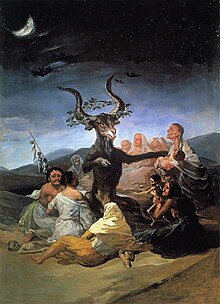
Akerbeltz or Aker ( From the basque language: Aker, billy goat and Beltz, black) is an spirit in the folk mithology of the Basque people. It lives inside the land and it has many elfs as servants. For the christianity, Akerbeltz is the live image of the demon. Priests, witches and seers think that he does all type of sexual abuses in the covens he organised.
Nowayadays, instead, it is said that Akerbeltz was an ancient deity which was the animals' protector. The billy goat was also adorated in other European countries and not only in the Basque Country. Some belifs about this mithologic criature have last until nowadays.
Akerbeltz during history and in other mithologies edit
Pierre de Lancrek, an inquisitor who went looking for women from Labourd and Lower Navarre who were supposed to be witches, wrote a book called "Tableu de I´Inostance", there, he wrote a testimony of a supposed witch: "Akerbeltz has a man's face, big and terrifying". Another witch also said that he had two faces, one in front and the other one in the back. In words of other inquisitors, Akerbeltz was similar to an enormous dog or to a big ox which is lied. This last case could be releated to the mith of the Aatxe (another criature of the Basque mithology). As men who look for witches said, Aker gave a parody of the catholic mass to his followers, and during the mass, they offer him eggs, bread and money.
<<Read: Akelarre if you want to get more iformation>>
In the mass explained before, Aker gave a parody sermon, and after that speech, he organised a lunch with his witches and elfs. In that lunch it was served human-meat and his horns functionated as gigant candles. To continue with the celebration, Aker and his followers danced together with the sound of a Basque drum. And finally, the witches made their spells.
Folklorists say that Akerbeltz was similar to some ancient deities such as Dyonisus, in terms of excesses, and Pan, in terms of sexual abuses.
Barandarian, a man who investegated and compiled the Basque culture, said that the picture of Akerbeltz was similar to Mari (another spirit from the Basque mithology) because they had some characteritics in common.
There were some other belifs which say that he was the animals' and houses' protector, and he had the power for treating the animals. He was also the life image of the fertility. And as he was black, many people from the Basque Country had had a blak bily-goat in their stable in order to protect the rest of the animals.
Tales edit
- He had the power for creating storms and to dress the animals he had under his care. That is why in some Baserri they used to have a billy-goat.
- He was supposed to be in the entrance of the caves of Zugarramurdi where elfs, lamia (Basque mithology), and witches met.
Once a priest entered a cave with a host. While he was touching the gold which he was wearing, a snake appeared and ate his hands so he left the cave without hands. From inside the cave some misterious voices could be heard, and they said :" thanks what you were wearing in your chest, because if not you will have to stay here". After this, it can be heard a Basque saying which sais: "Auza, han baduk gauza; baina neok ezin har".
- Neighbours from Baigorri say that Aker's ghost live in some caves in the area.
- In Urepel, from the Biurretabuxtan baserri Juan Monakok said that there was a cave full of gold, and near that gold there were a snake and Aker. Many times had a priest gone prying to the cave so that the snake and Akerbeltz go, but they have never go from there.
Other belifs of Akerbeltz edit
- Black billy-goats have always been very valuable in Aragoian and in the Basque Pyrenees because as the myths say, they can take care of the rest of the animals and the house.
- People from the Pyrenees thought that witches, Akerbeltz and the demon could go to any house and take the beard from a billy-goat in order to make hail. That is reason why in Freser they have always said: " A la casa han tosa la cabra, aquesta tarde tindrem pedra"; " They have cut the beard to the billy goat, this afternoon it is going to hail".
Bibliography edit
- Jose Miguel de Barandiaran, obras completas. Writer, Jose Miguel de Barandiaran. Editorial, Editorial la gran enciclopedia vasca, Bilbao 1976.
- Pequeño diccionario de mitologia vasca y pirenaica. Writer, Olivier de Marliave. Editorial, Alejandria, Barcelona 1995.